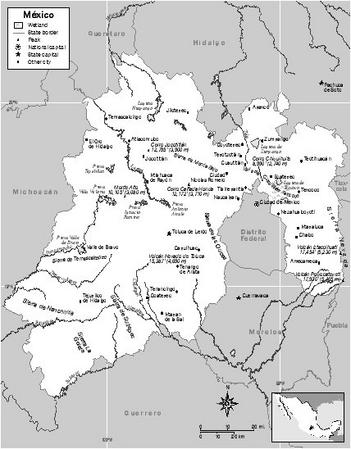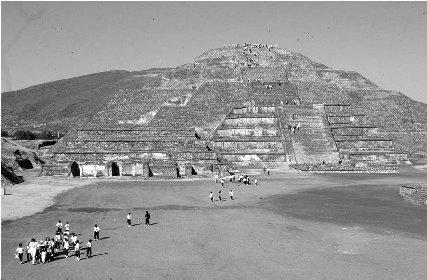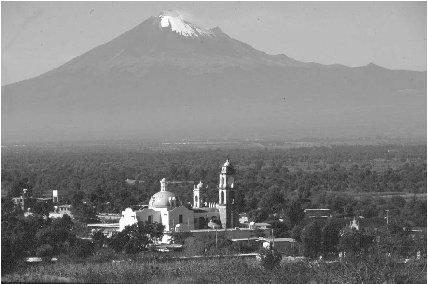México

Pronunciation: MEH-hee-koh.
Origin of state name: The state (and country) name comes from words in the language of the indigenous Náhuatl people: metztli (moon), xictli (center), and co (place).
Capital: Toluca.
Entered country: 1824.
Coat of Arms: A shield surrounded by gold trim, and a red border with the words "Libertad Travajo Cultura" (Spanish for "Freedom Work Culture"). In the upper left is a pyramid, representing the historic Aztec civilization; in the upper right, commemorating the Battle of Cross Mountain in the war for independence, two crosses rise above a green peak. A cannon is firing in front of the peak. The lower half of the shield features an open book with a pick and a spade, representing the rich ores found in the state. The yellow and brown rays in the background represent agriculture.
Holidays: Año Nuevo (New Year's Day—January 1); Día de la Constitución (Constitution Day—February 5); Benito Juárez's birthday (March 21); Primero de Mayo (Labor Day—May 1); Revolution Day, 1910 (November 20); and Navidad (Christmas—December 25).
Flag: There is no official state flag.
Time: 6 AM = noon Greenwich Mean Time (GMT).
1 Location and Size
México state is one of the thirty-one states of Mexico. Its capital, Toluca, lies near the center of the state. México state is bordered on the north by the Mexican states of Querétaro and Hidalgo; on the east by the Mexican states of Tlaxcala and Puebla; on the south by Distrito Federal (Federal District) and the Mexican states of Morelos and Guerrero; and on the west by the Mexican state of Michoacán. It has an area of 21,196 square kilometers (8,184 square miles), about the same size as the US state of Massachusetts. México has 122 municipalities.
The state of México is crossed by three parallel volcanic chains. There are mountains in the west, the Monte Alto and Las Cruces Mountains in the center of the state, and the Sierra Nevada in the east.
The northern region consists of flatlands and hills; in the south, there are mountains, canyons, and ravines; in the east, there are mountains and volcanoes; in the west, there are plains, hills, and mountains; and in the central area, there are extensive broad valleys surrounded by hills. One of the largest volcanoes is Iztaccíhuatl (5,286 meters/17,343 feet).
The state of México's rivers include the Lerma, the Tula, the Moctezuma, and the Pánuco. Some areas of the state, such as the valley of Cuautitlán-Texcoco, have no water resources.
2 Climate
The climate varies considerably by region. In the valley regions, the climate is hot and dry. Around the capital, Toluca, the climate is cooler. The average annual temperature range in Toluca is 12 to 17° c (54 to 63° f ). Rainfall in Toluca averages 800 to 900 millimeters (31 to 35 inches).
3 Plants and Animals
In the eastern part of the state, the mountains of the Sierra Nevada are covered with pine, oak, white cedar, and fir trees. Plants native to the valleys are cactus, nopal (similar to prickly pear), copal trees (a type of tree with heavy, thick resin), and gourds.
Native animals include coati (a raccoon-like animal) and deer. There are many bird species native to the state, including the sparrow hawk. The state of México and its southern neighbor, Michoacán, are winter home to hundreds of thousands of migrating monarch butterflies.
4 Environmental Protection
There is a reserve to protect the habitat of the migrating monarch butterflies. Its territory, which was expanded in 2001 to 54,000 hectares (133,400 acres), lies in both México and Michoacán. In 2003, the government of México was considering requiring its industrial plants to track pollutants. A national park, Parque Nacional Izta-Popo, covers the terrain around the volcanic peaks Iztacíhuatl and Popocatepetl. Popocatepetl, which lies in neighboring Puebla, is the highest active volcano in the Northern Hemisphere.
5 Population, Ethnic Groups, Languages
México had a total population of 13,096,686 in 2000; of the total, 6,407,213 were men and 6,689,473 were women. The population density was 586 people per square kilometer (1,517 people per square mile). In 2000, the capital of Toluca had a population of 665,617. About 97% of citizens speak Spanish as their first language; 3% speak one of the indigenous languages as their first language.
6 Religions
According to the 2000 census, 77% of the population, or ten million people, were Roman Catholic; 3%, or 423,068 people, were Protestant. That year there were also 12,354 Seventh-Day Adventists, 25,491 Mormons, 134,468 Jehovah's Witnesses, and 14,084 Jews. Over 280,000 people reported no religion.
7 Transportation
There are international airports in Toluca (Toluca-Alfonso Lopez Airport) and Mexico City that provide international flight service to México state. There are 1,227 kilometers (762 miles) of railroad tracks. A system of 9,510 kilometers (5,907 miles) of highways links the state with the rest of the country.


The Temple of the Moon at the head of the Street of the Dead in Michoacan de Ocampo includes ruins that date to 100 B . C .
8 History
First inhabited around 5000 B . C ., the central valley of México was the home to several different civilizations before the Aztecs settled in the region around the 13th century. Among the early civilizations, Olmec and Toltec groups built towns and religious centers. Perhaps the most important pre-Aztec constructions, the pyramids of the Sun and the Moon, belong to the Teotihuacan culture (200 to 800 A . D .). By the time the Spaniards arrived, Toltec groups inhabited the valley surrounding the capital city Tenochtitlán, where the Aztecs ruled.
Spanish conqueror Hernán Cortés (1485–1547) organized in Texcoco the attack on México-Tenochtitlán in 1521. Dutch Franciscan priests (from an order of the Roman Catholic Church) first settled in the region in 1523 to convert the large indigenous population that inhabited the central valley of México. Jesuits, Agustines, and Dominican priests (from other orders of Catholicism) joined the Catholic conversion efforts starting in the 1530s. The Tepozotlán convent was one of the most important Jesuit centers in the entire continent during the Spanish conquest of Mexico.
Yet, the diseases brought by the Spaniards and the oppression imposed upon the indigenous communities brought the population down from two million at the time of the conquest to about two hundred thousand a century later. Agricultural production and services to the growing capital city of México, one of the most important centers of Spanish colonial presence in the Americas, represented the region's main economic activities during the 17th and 18th centuries.
The independence movement quickly reached the then Province of México. The independence army overpowered the royalists (loyal to Spain) in Toluca and then moved on to Mexico City. The royalist opposition to independence was defeated in a bloody battle at Las Cruces Mountain in 1810. After the execution of independence leader José Morelos (1765–1815), the region was once again controlled by the royalist forces. Yet, the new independence movement in 1821 was finally successful in freeing the province from Spanish colonial rule. In 1827, the separation of Mexico City as the nation's capital forced the province of México to establish Toluca as the new state capital.
US troops briefly occupied the state in 1847. Constant administrative and political reforms assigned former state of México territories to newly created provinces and states during much of the 19th century. The state became a central fighting ground for the civil war between liberals and conservatives in the 1860s. Yet, after the liberals were victorious, the state was peacefully controlled first by liberal president Benito Juárez (1806–1872) and later by President Porfirio Díaz (1830–1915). During the years that Porfírio Díaz was in power, roads, bridges, and other structures were built. He also consolidated the central government and made it strong enough to begin to challenge the influence of the Roman Catholic Church and the large landowners. The years that Porfírio Díaz was in power (1877–1880 and 1884–1911) came to be known as the Porfiriato period.
Another revolution began in 1910 and became known as the Mexican Revolution. This new conflict caused friction in the state between large landowners and landless peasants. The creation of the Mexico Federal District (Mexico DF), as the nation's capital, at the end of the revolution in 1917, was the last time the state lost territory to newly created entities. Rapid urbanization and industrial development characterized the state's economy during most of the 20th century.
Although it is formally and legally a different state, with significant rural population, a significant share of the state's population inhabits the areas that surround Mexico DF and are thus considered today part of the larger metropolitan area of one of the most populated cities in the world.
9 State and Local Government
The powerful state governor is elected democratically every six years and cannot be immediately re-elected. The legislature is a unicameral (one) chamber comprised of forty-five members elected in single member districts and thirty members elected by proportional representation. Deputies serve for three-year terms and cannot be immediately re-elected. Because the Institutional Revolutionary Party (PRI) has dominated the executive and legislative branches throughout most of the 20th century, existing division of power and check-and-balances provisions have only been recently utilized as opposition parties have increased their presence in the legislature.
The 122 municipal governments that comprise the state of México hold municipal president and council member elections every three years. Immediate re-election is prohibited. Larger municipalities have more resources, especially those that border Mexico City.
10 Political Parties
The three main political parties in the country of Mexico are the Institutional Revolutionary Party (PRI), the National Action Party (PAN), and the Party of the Democratic Revolution (PRD). The PRI has controlled politics in the state of México since the end of the revolution. No other party has succeeded in winning a gubernatorial race in that state, although the PAN and the PRD have won important municipal presidencies. Governor Arturo Montiel Rojas was elected for a six-year term in 1999.
11 Judicial System
The Superior Tribunal of Justice is the highest court of the state of México. Its members are appointed by a special council of the judiciary and their nonrenewable term lasts for fifteen years. The renewal of justices is staggered to provide continuity to the high court. Only qualified and experienced attorneys can be appointed to the high court by the council of the judiciary. In addition, an electoral court and various local courts also constitute the state judicial system.
12 Economy
The state of México has a strong economy based in manufacturing and mining. It is also one of Mexico's major producers of staple crops. The Teotihuacan pyramids are an international tourist destination. The state of México's economic activity represents 10% of the national gross domestic product (GDP).
13 Industry
The state of México's chief industries are food processing, construction, motor vehicles, chemicals, textiles, paper, machinery and assembly industries, electric and electronic equipment and appliances. Twenty industrial parks are operating throughout the state with companies such as Chrysler, Ford, Nissan, Hoechst, Pfizer, and Motorola among them. Handicrafts, such as wooden carvings, pottery, metal, basketwork, and the paper lampshades, onyx, obsidian figures, and stone mortars of the Zumpango region are produced in México state.
14 Labor
The US Bureau of Labor Statistics reported that Mexican workers saw their wages increase 17%, from $2.09 per hour in 1999 to $2.46 per hour in 2000. (The average US worker earned $19.86 per hour in 2000.) After one year, workers are entitled by law to six days paid vacation.
15 Agriculture
Crops are grown in the state of México on large and small farms. Some of the farmland is irrigated while some is not. Cultivation of irrigated crops include the mango, avocado, orange, plum, nuts, mamey (similar to an apricot), and papaya. Non-irrigated crops are corn, wheat, alfalfa, maguey (cactus), lima beans, tomatoes, and beans.
16 Natural Resources
There are nine national parks located in the state of México. Visitors to the state's national parks can enjoy mountain climbing, fishing, camping, or horseback riding. In Nevado de Toluca National Park, there is a volcanic crater with two deep lakes. Scuba divers and hikers enjoy the natural environment of these crater lakes. Bird watching, especially hummingbirds, is popular in Zoquiapan y Anexas National Park. Sacramonte National Park features views of the Popocatépetl and Iztacíhuatl volcanoes from the top of Sacramonte Hill.
17 Energy and Power
Almost all of the energy in Mexico is provided by the Federal Electricity Commission (CFE). In February 2002, the CFE introduced new electric rates. For households that use less than 140 kilowatt hours per month, there was no rate increase. (This is about 75% of all households, according to CFE). After the rate increases in 2002, state of México residents were charged higher rates because they use more than the minimum electricity.
18 Health
The state of México has 71 general hospitals; 1,192 outpatient centers; and 183 surgical centers.
Most of the Mexican population is covered under a government health plan. The IMSS (Instituto Mexicano de Seguro Social) covers the general population. The ISSSTE (Instituto de Seguridad y Servicios Sociales de Trabajadores del Estado) covers state workers.
19 Housing
Over three-fourths of the housing available in the state of México is in good repair. Only 9% is in need of significant upgrading. These homes may not have running water or access to electricity.
20 Education
The system of public education was first started by President Benito Juárez in 1867. Public education in Mexico is free for students from ages six to sixteen. According to the 2000 census, there were approximately 2.7 million school-age students in the state. Many students elect to go to private schools. The thirty-one states of Mexico all have at least one state university. Universidad Autónoma del Estado de México (Independent University of the State of México) is in Toluca.
21 Arts
The state of México has its own Ballet Folklórico company. There are over fifteen theaters and thirty-nine cultural centers, located in Toluca and other cities. There are also several chapters of the French cultural society Alianza Francesa.
22 Libraries and Museums
The state of México has 587 branches of the national library system. There are also seventy-four museums. The capital city, Toluca, has a museum devoted to watercolor paintings, a museum of modern art, a science museum, botanical gardens, a stamp museum, and a museum of anthropology. The city of Teotihuacán, an excavated ruin, showcases the pyramids and city structure of the Aztec civilization.

Popocatepetl volcano viewed from the east, from a site between Tlaxcala and Puebla.
23 Media
The capital city, Toluca, has two daily newspapers, El Diario and El Sol de Toluca.
24 Tourism, Travel, and Recreation
The capital city, Toluca, is mainly an industrial city. Tourists often stay in Toluca hotels when they travel to visit the ruins of the Aztec ceremonial city Teotihuacán. At Teotihuacán, the famous Pyramids of the Sun and the Moon are located. Teotihuacán means "the place where men become gods." Ixtapán de la Sal is famous for its spas and thermal baths. The Parque Nacional Izta-Popo (Izta-Popo National Park) is the home of México's two famous volcanoes, Popocatépetl and Iztacíhuatl.
25 Sports
Toluca has a basketball team, La Ola, that plays in a 6,000-seat stadium. Nearby Mexico City has six soccer stadiums, including the 114,465-seat Estadio Azteca (Aztec Stadium). Toluca also has several minor league soccer teams, which play at the 26,000-seat Nemesio Diez stadium. Nezahualcoyotl has a professional soccer team, NEZA, which plays in the 37,075-seat Neza 86 stadium.
26 Famous People
Juana Inés de la Cruz (1651–1695) was a nun who became a well-known poet and outspoken supporter of women's rights.
27 Bibliography
Books
Carew-Miller, Anna. Famous People of Mexico. Philadelphia: Mason Crest Publishers, 2003.
DeAngelis, Gina. Mexico. Mankato, MN: Blue Earth Books, 2003.
Supples, Kevin. Mexico. Washington, DC: National Geographic Society, 2002.
Web Sites
Mexico for Kids. http://www.elbalero.gob.mx/index_kids.html (accessed on June 15, 2004).
Visit Mexico: State of Mexico. http://www.visitmexico.com/destinations/r_cen/s_mex/ (accessed on June 17, 2004).